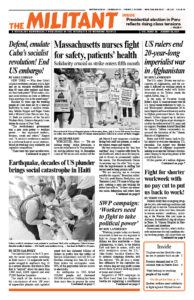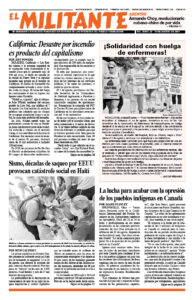Pedro Castillo, Peru’s newly elected president, took office July 28 in the midst of sharp political polarization and rising class tensions fed by a deepening economic and social crisis. Castillo, the candidate of Peru Libré (Free Peru), a party on the left of capitalist politics, defeated conservative Keiko Fujimori in a run-off by a razor-thin margin of 44,000 votes.
Fujimori and her ruling-class allies sought unsuccessfully to get the election results overturned. They and their imperialist allies in Washington claimed Castillo’s government was Marxist.
The change in government follows the deaths of more than 187,000 people from coronavirus, the world’s worst per capita death toll. Protests broke out in February after revelations that politicians and their relatives were given the COVID-19 vaccine months before the government began a public vaccination program.
Cuts on spending and the privatization of health care by previous governments have left working people with little or no access to medical care. In a country with a population of 32 million, there are only 276 mechanical ventilators, which are key to treating seriously ill coronavirus patients.
A quarter of Peru’s population lacks running water. Three out of four workers are self-employed in the “informal economy.” Many lost their family’s only source of income during strict COVID-related government lockdowns. While these forced many workers out of their jobs, it failed to contain infections. Some 10% more Peruvians now live in poverty than before the pandemic.
Castillo claims to be an ‘outsider’
Castillo, a former schoolteacher, union activist and small farmer, capitalized on long-simmering anger among working people. His campaign slogan, “No more poor people in a rich country,” helped him win votes, especially in the resource-rich southern Andes, where his promises to nationalize gas deposits and the mining industry got support.
Peru is one of the world’s top producers of copper, zinc, silver and gold, and has significant oil and natural gas resources. Around the world, mining companies are having some of the most profitable years on record, according to the Wall Street Journal. Profits for the top 40 mining companies are projected to be $118 billion in 2021 — up from $70 billion in 2020 and $61 billion in 2019. Meanwhile, governments in semicolonial countries like Peru, where mining is a key industry, face mounting debts to imperialist banks.
Under the government of Alberto Fujimori, conditions more favorable for capitalist investors in mining, oil, and logging operations were put in place in the 1990s. His regime suspended the constitution, tossed aside civil liberties and used brutal repression against its rivals. It also carried out widespread privatizations of banking and health care, cut subsidies and lifted price controls on basic necessities, ravaging the living standards of working people. These economic policies have been continued.
Top officials from the World Bank and International Monetary Fund lavished praise on Fujimori and every Peruvian government until now for managing the growth of the country’s capitalist economy at the expense of working people.
These policies also helped spawn a terrorist Maoist guerrilla force known as Sendero Luminoso, or Shining Path. This counterrevolutionary group was responsible for 12,000 killings, leading to brutal repression by the regime and further impoverishment of workers and peasants.
Alberto Fujimori, the father of Keiko Fujimori, is currently in prison after being convicted on corruption and murder charges. Largely supported by record high prices of commodities, Peru’s gross domestic product grew at an average annual rate of 5.6% between 2001 and 2016. But conditions for the majority of working people have been devastating.
Castillo is not the first bourgeois presidential candidate to run as an “outsider.” Nor is he the first to tap the hopes of working people, including indigenous populations long subject to discrimination, for greater control of the country’s resources. Ollanta Humala, elected in 2011, vowed to nationalize some industries, fight endemic corruption and excoriated the “neo-liberal model.”
Castillo’s campaign claims — touted in the capitalist media as a radical “socialist” agenda — rattled national and foreign investors. The value of the country’s currency, the sol, plunged after the election and inflation has risen. Since then, Castillo has reassured mining bosses that their interests are safe. He says he now favors “prudent” tax reforms instead.
“We are not Chavistas, we are not communists, we are not extremists,” Castillo said last month.
His government has taken Peru out of the Lima group of Latin American nations over that group’s calls for intervention to overturn the government of Venezuela. Peruvian Foreign Minister Héctor Béjar called July 30 for an end to Washington’s sanctions targeting the Nicolás Maduro government.
Castillo has backed off from his campaign call for a constitutional assembly to rewrite the 1993 charter written under Alberto Fujimori.
The need to replace the current constitution is presented by those on the left of capitalist politics in Peru as the main task ahead. They offer no program for mobilizing working people to fight for jobs, universal health care, greater control of production to protect land and labor, and other demands that can improve conditions.
These are the kinds of struggles, organized against the employers and their capitalist government, through which workers and farmers can chart a course forward. The best guide is the example of the Cuban Revolution, where Fidel Castro and the July 26 Movement led working people to take political power into their own hands and carry through a socialist revolution.


